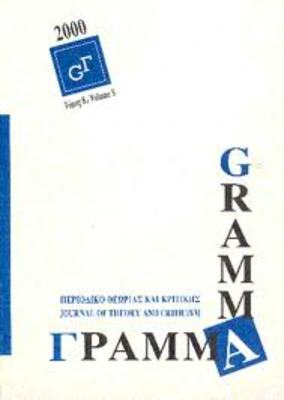Remix Semiosis as Ideology Critique : A Visual Semiotic Study of Critical Remix Video
Part of : Γράμμα : περιοδικό θεωρίας και κριτικής ; Vol.20, 2012, pages 127-144
Issue:
Pages:
127-144
Author:
Abstract:
Critical Remix Video (CRV) has become a potentially powerful and persuasivealternative to mainstream commercial advertising. Many producersof such work seek to convince audiences that dominant media messagescommunicate inherently false ideological meanings by exposing contradictionsand hypocrisies in these messages. However, CRVs themselvescommunicate equally contradictory ideological meanings in employingtechniques of media manipulation, deception and censorship in their design.This study interrogates and deconstructs the visual signs in CRVs and exploresthe role and influence of ideology in the construction of meaningscommunicated to online audiences by such work. The findings of this inquiryshould increase our understanding of how CRVs are constructed andwhy they are produced and enable future producers to improve the efficacyof subsequent iterations by revealing the inherent weaknesses in the currentstate of the art. A visual semiotic analysis of a representative sample ofCRVs was carried out which found that in the process of unmasking theideology in the subject of its critique, each CRV formulated a counter-ideologyand made truth-claims that are equally susceptible to subsequent critique.Inadvertently, CRVs enable us to see more clearly that claims to truth,whether received through mainstream or alternative channels, cannot beaccepted at face value and must be critically evaluated and considered inrelation to the relative positions of the senders and receivers of the messages.Despite such dilemmas, CRVs represent an authentic opportunityfor grassroots activist filmmakers to have their voices heard on a globalstage, utilizing the full potential of digital networking and mobile technologiesas well as spreadable media content and online distribution platforms
Subject:
Subject (LC):
References (1):
- Baio, Andy. “The Video Remix ‘Supercut’ Comes of Age”. Wired Jan.2011. Web.http://www.wired.com/business/2011/11/supercut/, retrieved 14th August 2012.Barthes, Roland. Mythologies. New York: Hill and Wang, 1957. Print.––. “Rhetoric of the Image”. Image-Music-Text. London: Fontana, 1977. 15-31. Print.Berger, Arthur Asa. Ads, Fads and Consumer Culture. USA: Rowman and Littlefield,2011. 167-174. Print.Chomsky, Noam and Edward S. Herman. Manufacturing Consent: The Political Economyof the Mass Media. USA: Pantheon, 2002. 1-36. Print.Deely, John. Basics of Semiotics. USA: Indian University Press, 1990. 22-49. Print.Eco, Umberto. A Theory of Semiotics. Bloomington, IN: Indiana University Press/London:Macmillan, 1976. 9-13. Print.––. “Narrative Structure in Fleming”. The Bond Affair. London: Macdonald, 1966. Print.Ewen, Stuart. Captains of Consciousness: Advertising and The Social Roots of the ConsumerCulture. New York: Basic Books, 2001. 25-57. Print.Fiske, John. Television Culture. London: Routledge, 1987. Print.Fletcher, Michael A. “Fiscal Trouble Ahead for Most Future Retirees”. Washington PostFebruary 17th, 2013. Print.Floch, Jean-Marie. Visual Identities. Trans. Pierre Van Osselaer and Alec McHoul. London:Continuum, 2000. Print.Gallagher, Owen. “History of Remix”. Remix Theory and Praxis Online Seminar Group.Ireland: RemixStudies.org, 2011. Web.Geisler, Gary and Sam Burns. “Tagging video: Conventions and strategies of the YouTubecommunity”. JCDL ‘07 Proceedings of the 7th ACM/IEEE-CS joint conference onDigital libraries. New York: ACM, 2007. 480-480. Web.Gramsci, Antonio. Prison Notebooks. Vols 1,2,3. Ed. Joseph A. Buttigieg. USA: ColumbiaUniversity Press, 2011. Print.Hall, Stuart. “Encoding/decoding”. Culture, Media, Language: Working Papers in CulturalStudies, 1972-79. London: Hutchinson, 1980. Centre for Contemporary CulturalStudies. 128-38. Print.Hall, Stuart. “The Rediscovery of ‘Ideology’”. Return of the Repressed in Media Studies.UK: Gurevitch, 1982. Print.Hjelmslev, Louis. Prolegomena to a Theory of Language. Madison: University of WisconsinPress, 1961. Print.Hodge, Robert and David Tripp. Children and Television: A Semiotic Approach. Cambridge:Polity Press, 1986. Print.Horwatt, Eli. “A Taxonomy of Digital Video Remixing: Contemporary Found FootagePractice on the Internet”. Cultural Borrowings. UK: Scope, 2009. Print.John, David, C. “Time to Address the Retirement Savings Crisis”. Retirement Security.USA: The Heritage Foundation, 2012. Web.http://www.heritage.org/research/reports/2012/10/time-to-address-the-retirementsavings-crisis, retrieved 1st March 2013.Kopacz, Maria A. And Bessie Lee Lawton. “The YouTube Indian: Portrayals of NativeAmericans on a Viral Video Site”. New Media and Society 13.2 (2011): 330-349.Print.Kreisinger, Elisa. “What is a remix, exactly?” Pop Culture Pirate. USA:ElisaKreisinger.wordpress.com, 2011. Web.Lessig, Lawrence. Remix: Making Art and Commerce Thrive in the Hybrid Economy.New York: Penguin Press, 2008. Print.McIntosh, Jonathan. “A History of Subversive Remix Video before YouTube: Thirty PoliticalVideo Mashups Made between World War II and 2005”. Fan/Remix Video.Ed. Francesca Coppa and Julie Levin Russo. Special issue, Transformative Worksand Cultures 1.9 (2012). Web.Manovich, Lev. Software Takes Command. USA: SoftwareStudies.com, 2008. Web.Marx, Karl and Friedrich Engels. Marx and Engels Correspondence. Trans. Donna Torr.USA: International Publishers, 1968 [1893]. Print.Merriam-Webster. “Mash-up”. Online Dictionary. USA: Merriam-Webster.com, 2012.Web.Metz, Christian. Film Language: A Semiotics of the Cinema. Trans. Michael Taylor. NewYork: Oxford University Press, 1974. Print.––. Methodological Propositions for the Analysis of Film. USA: Eaton, 1981. 86-98.Print.Moriarty, Sandra. “Visual semiotics and the production of meaning in advertising”. VisualCommunication Division of AEJMC. Washington DC: AEJMC, 1995. 1-15. Web.––. “The Symbiotics of Semiotics and Visual Communication”. Journal of Visual Literacy22.1 (2002): 19-28. Print.Munnell, Alicia H., Anthony Webb and Francesca Gollub-Sass. “The National RetirementRisk Index: An Update”. Center for Retirement Research. (No.12-20). USA: BostonCollege, 2012. Web. http://crr.bc.edu/wp-content/uploads/2012/11/IB_12-20.pdf,retrieved 1st March 2013.Navas, Eduardo. “Regressive and Reflexive Mashups in Sampling Culture”. MashupCultures. Ed. Stefan Sonvilla-Weiss. New York: Springer-Wein, 2010. 157-177.Print.Nöth, Winfried. Handbook of Semiotics. USA: Indiana University Press, 1995. 419-480.Print.Peirce, Charles Sanders. Collected Writings. 8 Vols. Ed. Charles Hartshorne, Paul Weissand Arthur W. Burks. Cambridge, MA: Harvard University Press, 1931-58. Print.Peverini, Paolo. “The aesthetics of music videos: An open debate”. Rewind, Play, FastForward: The Past, Present and Future of the Music Video. Ed. Henry Keazer etal. Germany: Transcript Verlag, 2008. 135-154. Print.Saussure, Ferdinand de. Course in General Linguistics. Trans. Roy Harris. London:Duckworth, 1983 [1916]. Print.Scott, Linda. “Images in Advertising: The Need for a Theory of Visual Rhetoric”. Journalof Consumer Research. 1.21 (1994): 252-73. Print.Sonesson, Göran. Current Issues in Pictorial Semiotics. USA: Semiotics Institute Online,2002. Web. http://www.univie.ac.at/wissenschaftstheorie/srb/cyber/soneout.html,retrieved 12th August 2012.Van Leeuwen, Theo. “Semiotics and Iconography”. The Handbook of Visual Analysis.USA: Sage Publications, 2000. Print.Williamson, Judith. Decoding Advertisements: Ideology and Meaning in Advertising.London: Marion Boyars, 1978. Print.Woodfin, Rupert and Oscar Zarate. Introducing Marxism. USA: Icon Books, 2004. 122-124. Print.FilmographyOgilvie, Corey. I Am Not Moving. 2011. Canada. Web.http://www.youtube.com/watch?v=RGRXCgMdz9A retrieved 14th August 2012Gallagher, Owen. Man of the Year: How Jon Stewart Became President. 2011. Ireland.Web.http://www.youtube.com/watch?v=kOuu1b81ogU retrieved 14th August 2012De Vellis, Philip. Vote Different. 2007. USA.Web.http://www.youtube.com/watch?v=6h3G-lMZxjo retrieved 14th August 2012




